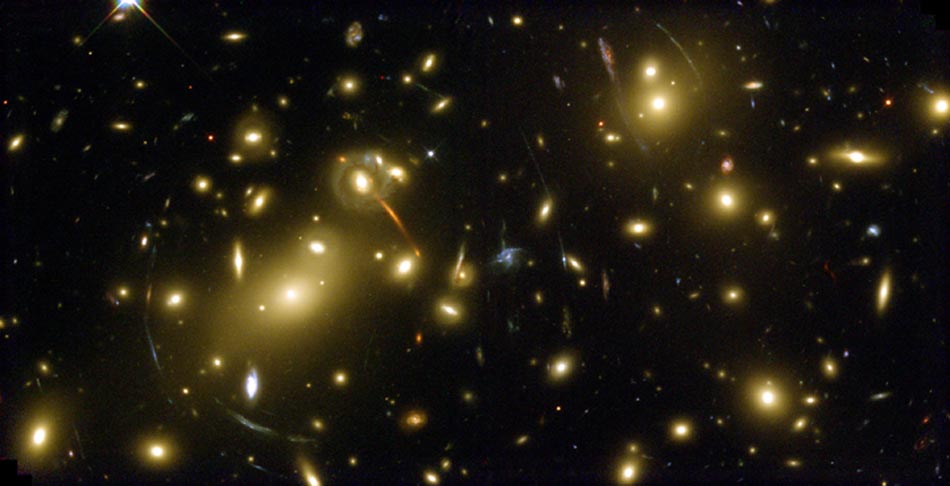
Creates Giant "Lens"
Description: Galaxy Cluster, Gravitational Lens
Position (J2000): R.A. 16h 35m 54.00s Dec. +66° 13' 00.0"
Constellation: Draco
Distance: 2 billion light-years (600 million parsecs)
Instrument: WFPC2
Exposure Date(s): January 11 - 13, 2000
Exposure Time: 9.4 hours
Filters: F450W (Wide B), F606W (Wide V), F814W (I)
Image Credit: NASA, A. Fruchter and the ERO Team (STScI)
Release Date: January 24, 2000
ABOUT THIS IMAGE:
Scanning the heavens for the first time since the successful December 1999 servicing mission, NASA's Hubble Space Telescope has imaged a giant, cosmic magnifying glass, a massive cluster of galaxies called Abell 2218. This "hefty" cluster resides in the constellation Draco, some 2 billion light-years from Earth.
The cluster is so massive that its enormous gravitational field deflects light rays passing through it, much as an optical lens bends light to form an image. This phenomenon, called gravitational lensing, magnifies, brightens, and distorts images from faraway objects. The cluster's magnifying powers provides a powerful "zoom lens" for viewing distant galaxies that could not normally be observed with the largest telescopes.
This useful phenomenon has produced the arc-shaped patterns found throughout the Hubble picture. These "arcs" are the distorted images of very distant galaxies, which lie 5 to 10 times farther than the lensing cluster. This distant population existed when the universe was just a quarter of its present age. Through gravitational lensing these remote objects are magnified, enabling scientists to study them in more detail. This analysis provides a direct glimpse of how star-forming regions are distributed in remote galaxies and yields other clues to the early evolution of galaxies.
The picture is dominated by spiral and elliptical galaxies. Resembling a string of tree lights, the biggest and brightest galaxies are members of the foreground cluster. Researchers are intrigued by a tiny red dot just left of top center. This dot may be an extremely remote object made visible by the cluster's magnifying powers. Further investigation is needed to confirm the object's identity.
The Hubble telescope first viewed this cluster in 1994, producing one of the most spectacular demonstrations of gravitational lensing up to that time. Scientists who analyzed that black-and-white picture discovered more than 50 remote, young galaxies. Hubble's latest multicolor image of the cluster will allow astronomers to probe in greater detail the internal structure of these early galaxies. The color picture already reveals several arc-shaped features that are embedded in the cluster and cannot be easily seen in the black-and-white image.
The colors in this picture yield clues to the ages, distances, and temperatures of stars, the stuff of galaxies. Blue pinpoints hot young stars. The yellow-white color of several of the galaxies represents the combined light of many stars. Red identifies cool stars, old stars, and the glow of stars in distant galaxies. This view is only possible by combining Hubble's unique image quality with the rare lensing effect provided by the magnifying cluster.
The picture was taken Jan. 11 to 13, 2000, with the Wide Field and Planetary Camera 2.